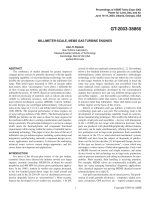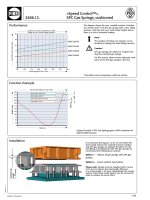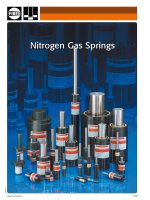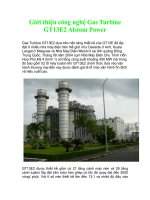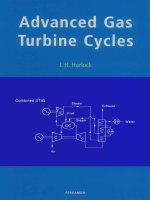Advanced Gas Turbine Cycles pdf
Bạn đang xem bản rút gọn của tài liệu. Xem và tải ngay bản đầy đủ của tài liệu tại đây (5.04 MB, 230 trang )
Advanced
Gas
Turbine
Cycles
Corn
bined
STlG
Steam
-
Exhaust
4
1i
li
qL
t
Air
Water
PERGAMON
ADVANCED GAS
TURBINE
CYCLES
ADVANCED
GAS
TURBINE
CYCLES
J.
H.
Horlock
F.R.Eng., F.R.S.
Whittle
Laboratory
Cambridge,
U.K.
2003
An
imprint
of
Elsevier
Science
AMSTERDAM
*
BOSTON
.
HEIDELBERG
.
LONDON
.
NEW
YORK
OXFORD
.
PARIS
*
SAN
DEGO
*
SAN FRANCISCO
SINGAPORE
SYDNEY
.
TOKYO
ELSEVIER SCIENCE Ltd
The Boulevard, Langford Lane
Kidlington, Oxford
OX5
lGB,
UK
0
2003 Elsevier Science Ltd. All rights reserved.
This work is protected under copyright by Elsevier Science, and the following terms and conditions apply to its use:
Photocopying
Single photocopies of single chapters may be made for personal use as allowed by national copyright laws. Permission of
the Publisher and payment of a fee is required for all other photocopying, including multiple or systematic copying,
copying for advertising
or
promotional purposes, resale, and all forms of document delivery. Special rates are available
for
educational institutions that wish to make photocopies for non-profit educational classroom use.
Permissions may be sought directly from Elsevier’s Science
&
Technology Rights Department in Oxford, UK phone:
(4)
1865 843830, fax:
(4)
1865 853333, e-mail:
You
may also complete your request
on-line via the Elsevier Science homepage
(),
by selecting ‘Customer Support’ and then
‘Obtaining Permissions’.
In
the USA, users may clear permissions and make payments through the Copyright Clearance Center, Inc., 222
Rosewood Drive, Danvers, MA 01923, USA; phone: (+1) (978) 7508400, fax: 7504744, and in the UK through the
Copyright Licensing Agency Rapid Clearance Service (CLARCS),
90
Tottenham Court Road, London W1P OLP, UK
phone:
(4)
207 631 5555; fax:
(4)
207 631 5500. Other countries may have a local reprographic rights agency for
payments.
Derivative Works
Tables of contents may be reproduced for internal circulation, but permission of Elsevier Science is required for external
resale
or
distribution of such material.
Permission of the Publisher is required for all other derivative works, including compilations and translations.
Electronic Storage or Usage
Permission of the Publisher is required to store or use electronically any material contained in this work, including any
chapter or part
of
a chapter.
Except
as
outlined above, no part of this work may be reproduced, stored in a retrieval system
or
transmitted in any form
or by any means, electronic, mechanical, photocopying, recording
or
otherwise, without prior written permission of the
Publisher.
Address permissions requests to: Elsevier’s Science
&
Technology Rights Department, at the phone, fax and e-mail
addresses noted above.
Notice
No responsibility is assumed by the Publisher for any injury andor damage to persons or property as a matter of products
liability, negligence or otherwise, or from any use or operation of any methods, products, instructions or ideas contained
in the material herein. Because
of
rapid advances in the medical sciences, in particular, independent verification of
diagnoses and drug dosages should
be
made.
First edition 2003
Library of Congress Cataloging in Publication Data
A
catalog record
from
the Library
of
Congress has been applied
for.
British Library Cataloguing in Publication Data
A
catalogue record
from
the British Library has been applied
for.
ISBN 0-08-044273-0
@
The paper used in this publication meets the requirements of
ANSI/NISO
239.48-1992 (Permanence of Paper).
Printed in The Netherlands
To
W.R.H.
Preface
Notation
Chapter
1
.
A
brief review of power generation thermodynamics
1.1.
1.2.
1.2.1.
1.2.2.
1.2.3.
1.2.4.
1.3.
1.4.
1.5.
Introduction
Criteria for the performance of power plants
Efficiency of a closed circuit gas turbine plant
Efficiency of
an
open circuit gas turbine plant
Heatrate
Energy utilisation factor
Ideal (Carnot) power plant performance
Limitations of other cycles
Modifications of gas turbine cycles to achieve higher
thermalefficiency
References
Chapter
2
.
Reversibility and availability
2.1.
2.2.
2.2.1.
2.2.2.
2.3.1.
2.3.2.
2.3.
2.4.
2.5.
2.6.
2.7.
Introduction
Reversibility. availability and exergy
Flow in the presence of an environment at
To
(not
involving chemical reaction)
Flow with heat transfer at temperature
T
Exergy flux
Application of the exergy flux equation to a closed cycle
The relationships between
6.
(+and
ZCR.
ZQ
The maximum work output in a chemical reaction at
To
The adiabatic combustion process
The work output and rational efficiency of an open circuit
gas turbine
A final comment on the use of exergy
References
Chapter
3
Basic gas turbine cycles
3.1.
Introduction
xiii
xvii
1
9
11
13
13
14
14
16
19
20
20
22
23
24
26
26
27
27
vii
viii
Confenrs
3.2.
3.2.1.
3.2.1.1.
3.2.1.2.
3.2.1.3.
3.2.1.4.
3.2.1.5.
3.2.2.1.
3.2.2.2.
3.2.2.3.
3.2.2.
3.2.3.
3.3.
3.4.
3.4.1.
3.4.2.
3.5.
Chapter
4
.
4.1.
4.2.
4.2.1.
4.2,l.l.
4.2.1.2.
4.2.1.3.
4.2.1.4.
4.2.2.1.
4.2.2.2.
4.2.2.
4.2.2.3.
4.2.2.4.
4.2.2.5.
4.3.
4.3.1.
4.3.2.
4.3.2.1.
4.3.2.2.
4.3.3.
Air standard cycles (uncooled)
28
Reversible cycles
28
The reversible simple (Joule-Brayton) cycle. [CHTIR
28
The reversible recuperative cycle [Cm]R
29
30
The reversible intercooled cycle [CICHTIR
32
The 'ultimate' gas turbine cycle
32
Irreversible air standard cycles
33
Component performance
33
The irreversible simple cycle [CHTII
34
The irreversible recuperative cycle [CHTXII
37
Discussion
39
The [CBTII open circuit plant-a general approach
39
Computer calculations for open circuit gas turbines
43
The [CBTIIG plant
43
Comparison of several
types
of gas turbine plants
44
Discussion
45
References
46
The reversible reheat cycle [CHTHTIR
Cycle efficiency with turbine cooling (cooling
flow
ratesspecified)
47
Introduction
47
Air-standard cooled cycles
48
Cooling of internally reversible cycles
49
Cycle [CHTIRCI with single step cooling
49
Cycle [cHT]RC* with
two
step cooling
51
Cycle [cHT]Rm with multi-step cooling
52
54
Cooling of irreversible cycles
55
Cycle with single-step cooling [CH'I'IIcl
55
rotor inlet temperature (for single-step cooling)
56
Cycle with two step cooling [CHTIIa
58
Cycle with multi-step cooling [CHTlICM
59
Comment
59
Open cooling
of
turbine blade rows-detailed fluid
mechanics and thermodynamics
59
Introduction
59
Change in stagnation enthalpy (or temperature) through
Change of total pressure through
an
open cooled blade row
The turbine exit condition (for reversible cooled cycles)
Efficiency as a function of combustion temperature or
The simple approach
61
an open cooled blade row
Breakdown of losses in the cooling process
61
62
64
Contents ix
4.4.
4.5.
Cycle calculations with turbine cooling
65
Conclusions
68
References
69
Chapter
5
.
Full
calculations
of
plant
efficiency
71
5.1.
5.2.
5.2.1.
5.2.2.
5.2.3.
5.3.
5.4.
5.5.
5.6.
5.7.
5.8.
5.9.
Introduction
71
Cooling flow requirements
71
Convective cooling
71
Film cooling
72
Assumptions for cycle calculations
73
Estimates
of
cooling flow fraction
73
Single step cooling
75
Multi-stage cooling
75
A note on real gas effects
82
Other studies of
gas
turbine plants with turbine cooling
82
Exergy calculations
82
Conclusions
84
References
84
Chapter
6
.
‘Wet’
gas
turbine
plants
85
6.1.
6.2.
6.2.1.
6.2.2.
6.3.1.
6.3.
6.3.2.
6.4.1.
6.4.
6.4.1
.
1.
6.4.1.2.
6.4.1.3.
6.4.2.1.
6.4.2.2.
6.4.2.3.
6.4.2.4.
6.4.2.5.
6.4.2.
6.4.3.
Introduction
Simple analyses of STIG
type
plants
The basic STIG plant
The recuperative STIG plant
Simple analyses
of
EGT
type
plants
The simple EGT plant with water injection
Recent developments
Developments of the STIG cycle
The ISTIG cycle
A discussion of
dry
recuperative plants with ideal heat
exchangers
The combined STIG cycle
The FAST cycle
Developments of
the
EGT cycle
The
RWI
cycle
The HAT cycle
The REVAP cycle
The CHAT cycle
The TOPHAT cycle
Simpler direct water injection cycles
85
85
85
90
91
91
93
97
97
97
99
99
99
100
100
100
101
101
103
X
6.5.
6.6.
6.7.
Chapter
7
.
7.1.
7.2.
7.3.
7.4.
7.4.1.
7.4.2.
7.4.3.
7.5.1.
7.5.2.
7.5.
7.6.
7.7.
7.8.
Chapter
8
.
8.1.
8.2.
8.2.1.
8.2.2.
8.2.3.
8.2.4.
8.2.5.
8.3.1.
8.3.2.
8.3.
8.4.
8.5.
8.5.1.
8.5.2.
8.5.3.
Contents
A discussion of the basic thermodynamics of
these developments
Conclusions
References
Some detailed parametric studies of wet cycles
The combined cycle
gas
turbine (CCGT)
Introduction
A
combined plant with heat loss between
two
cyclic
plants in series
An
ideal combination of cyclic plants
The combined cycle gas turbine plant (QCGT)
The exhaust heated (unfired) CCGT
The integrated coal gasification combined
cycle plant (IGCC)
The exhaust heated (supplementary fired) CCGT
The efficiency of an exhaust heated CCGT plant
The optimum pressure ratio for a CCGT plant
Reheating in the upper gas turbine cycle
A
parametric calculation
Regenerative feed heating
Discussion and conclusions
References
Novel
gas
turbine cycles
Introduction
Plants (A) with addition of equipment to remove the carbon
dioxide produced in combustion
Plants
(B)
with modification of the fuel in
combustion-chemically reformed gas turbine
(CRGT) cycles
Classification of gas-fired plants using novel cycles
Plants (C) using non-carbon fuel (hydrogen)
Plants (D) with modification of the oxidant in combustion
Outline of discussion of novel cycles
COz removal equipment
The chemical absorption process
The physical absorption process
Semi-closure
The chemical reactions involved in various cycles
Complete combustion in a conventional open circuit plant
Thermo-chemical recuperation using steam (steam.TCR)
103
105
107
107
109
109
109
110
111
112
114
116
117
118
122
123
126
128
129
131
131
132
132
133
133
135
135
136
136
136
139
140
140
141
Partial oxidation
143
Contents
xi
8.5.4.
8.5.5.
8.6.1.
8.6.
8.6.1.1.
8.6.1.2.
8.6.2.
8.6.2.1.
8.6.2.2.
8.6.3.
8.6.4.
8.6.4.1.
8.6.4.2.
8.7.
8.8.
Thermo-chemical recuperation using flue gases
Combustion with recycled flue gas as a carrier
Cycles A with additional removal equipment for carbon
Direct removal
of
COz from an existing plant
Modifications of the cycles of conventional plants using
the
Cycles
B
with modification of the fuel in combustion
through thenno-chemical recuperation (TCR)
The flue gas thermo-chemically recuperated (FG/TCR) cycle
.
Cycles C burning non-carbon fuel (hydrogen)
Cycles D with modification of the oxidant in combustion
(fluegas/TCR)
143
Descriptions of cycles
144
dioxide sequestration
144
semi-closed gas turbine cycle concept
The steam/TCR cycle
149
144
144
146
147
150
152
154
Partial oxidation cycles
155
Plants with combustion modification (full oxidation)
158
IGCC cycles with C02 removal (Cycles E)
160
Summary
162
References
164
CHAPTER
9
.
The gas turbine
as
a cogeneration
167
(combined
heat
and power)
plant
9.1.
9.2.
9.2.1.
9.2.2.
9.2.3.
9.3.
9.4.
9.5.
9.6.
9.6.1.
9.6.2.
Introduction
167
Performance criteria for CHP plants
168
Energy utilisation factor
168
Artificial thermal efficiency
170
Fuel energy saving ratio
The unmatched gas turbine CHP plant
170
173
174
177
177
The Beilen CHP plant
177
The Liverpool University CHP plant
180
References
181
Range of operation for a gas turbine CHP plant
Design of gas turbines
as
cogeneration (CHP) plants
Some practical gas turbine cogeneration plants
APPENDIX
A
.
Derivation
of
required cooling
flows
183
A.l. Introduction
183
A.2. Convective cooling only
183
A.3. Film cooling
185
A.4. The cooling efficiency
186
xii
contmrs
AS
.
Summary
186
References
187
APPENDIX
B
.
Economics
of
gas
turbine
plants
189
B.I.
Introduction
189
B.2.
Electricity pricing
189
B.3.
The capital charge factor
190
B.4.
Examples
of
electricity pricing
191
References
194
B.5.
Carbon dioxide production and
the
effects of a
carbon
tax
192
Index
195
PREFACE
Many people have described the genius of von Ohain in Germany and Whittle in the
United Kingdom, in their parallel inventions of gas turbine jet propulsion; each developed
an engine through to first flight. The best account of Whittle’s work is
his
Clayton lecture
of 1946 [l]; von Ohain described his work later in [2]. Their major invention was the
turbojet engine, rather than the gas turbine, which they both adopted for their new
propulsion engines.
Feilden and Hawthorne
[3]
describe Whittle’s early thinking in their excellent
biographical memoir on Whittle for the Royal Society.
“‘I‘he idea for the turbojet did not come to Whittle suddenly, but over a period
of some years: initially while he was a final year flight cadet at RAF Cranwell
about 1928; subsequently
as
a pilot officer in a fighter squadron; and then
finally while he was a pupil on a flying instructor’s
course
. .
While involved
in these duties Whittle continued to
think
about his ideas for high-speed high
altitude flight. One scheme he considered was using a piston engine to drive a
blower to produce a jet. He included the possibility of burning extra fuel in the
jet pipe but finally had the idea
of
a gas turbine producing a propelling jet
instead of driving a propeller”.
But the idea of gas turbine itself can
be
traced back to a 1791 patent by Barber, who
wrote of
the
basic concept of a heat engine for power generation.
Air
and gas were to
be
compressed and burned to produce combustion products; these were to be used to drive a
turbine producing a work output. The compressor could be driven independently (along
the lines of Whittle’s early thoughts) or by the turbine itself if it was producing enough
work.
Here lies the crux of the major problem in the early development of the gas turbine. The
compressor must
be
highly efficient-it must use the minimum power to compress the gas;
the turbine must also
be
highly efficient-it must deliver the maximum power if it is to
drive the compressor and have power over. With low compressor and turbine efficiency,
the plant can only just
be
self-sustaining-the turbine can drive the compressor but do no
more than that.
Stodola in his great book of 1925 [4] describes several gas turbines for power
generation, and Whittle spent much time studying this work carefully. Stodola tells how in
1904,
two
French engineers, Armengaud and Lemae, built one of
the
first gas turbines, but
it did little more than
turn
itself over. It appears they used some steam injection and the
small work output produced extra compressed air-but not much. The overall efficiency
has been estimated at
2-3%
and the effective work output at
6-
10 kW.
Much later,
after several years of development (see Eckardt and Rufli
[5]),
Brown Boveri produced the first industrial gas turbine in 1939, with an electrical power
xiii
xiv
Prefwe
output of 4MW. Here the objective of the engineering designer was to develop as much
power as possible in the turbine, discharging the final gas at low temperature and velocity;
as
opposed to the objective in the Whittle patent of 1930, in which any excess energy in the
gases at exhaust from the gas generator-the turbine driving the compressor-would be
used to produce a high-speed jet capable of propelling an aircraft.
It was the wartime work on the turbojet which provided a new stimulus to the further
development of the gas turbine for electric power generation, when many of the aircraft
engineers involved in
the
turbojet work moved over to heavy gas turbine design. But
surprisingly it was
to
be the late twentieth century before the gas turbine became a major
force in electrical generation through the big CCGTs (combined cycle gas turbines, using
bottoming
steam
cycles).
This
book describes the thermodynamics of gas turbine cycles (although it does touch
briefly on the economics of electrical power generation). The strictures of classical
thermodynamics require that “cycle” is used only for a heat engine operating in closed
form, but the word has come to cover “open circuit” gas turbine plants, receiving “heat”
supplied through burning fuel, and eventually discharging the products to the atmosphere
(including crucially the carbon dioxide produced in combustion). The search for high gas
turbine efficiency
has
produced many suggestions for variations on the simple “open
circuit” plant suggested by Barber, but more recently work
has
been directed towards gas
turbines which produce less COz, or at least plants from which the carbon dioxide can be
disposed of, subsequent to sequestration.
There
are
many
books
on gas turbine theory and performance, notably by Hodge [6],
Cohen, Rogers and Saravanamuttoo [7], Kerrebrock [8], and more recently by Walsh and
Fletcher [9]; I myself have added
two
books on combined heat and power and on
combined power plants respectively [10,11]. They all range more widely than the basic
thermodynamics of gas turbine cycles, and the recent
flurry
of
activity
in this field has
encouraged me to devote
this
volume to cycles alone. But the remaining breadth of gas
turbine cycles proposed for power generation has led me to exclude from
this
volume the
coupling of the gas turbine with propulsion.
I
was also influenced in this decision by the
existence of several good
books
on aircraft propulsion, notably by Zucrow [12], Hill and
Peterson [13]; and more recently my friend
Dr
Nicholas Cumpsty, Chief Technologist of
Rolls
Royce, plc, has written an excellent book on “Jet Propulsion”
[
141.
I first became interested in the subject of cycles when I went
on
sabbatical leave to
MIT,
from Cambridge England to Cambridge
Mass.
There
I
was asked by the Director of
the Gas Turbine Laboratory, Professor E.S.Taylor, to take over his class on gas turbine
cycles for the year. The established text for
this
course consisted of a beautiful set of
notes on cycles by Professor (Sir) William Hawthorne, who had been a member of
Whittle’s
team.
Hawthorne’s notes remain the best starting point for the subject and I
have called upon them here, particularly
in
the early part
of
Chapter 3.
Hawthorne taught me the power of temperature-entropy diagram in the study of cycles,
particularly in
his
discussion of “air standard” cycles-assuming the working fluid to
be
a
perfect gas, with constant specific heats. It is interesting that Whittle wrote in
his
later
book
[15] that he himself “never found the
(T,s
diagram) to
be
useful”, although he had a
profound understanding of the basic thermodynamics of gas turbine cycles. For he also
wrote
Preface
xv
“When in jet engine design, greater accuracy was necessary for detail design, I worked
in pressure ratios, used
y
=
1.4
for compression and
y
=
1.3
for expansion and assumed
specific heats for combustion and expansion corresponding to the temperature range
concerned. I also allowed for the increase in mass flow in expansion due to fuel addition
(in the range
1.5-2%).
The results, despite guesswork involved in many of the
assumptions, amply justified these methods to the point where
I
was once rash enough to
declare that jet engine design has become an exact science”. Whittle’s modifications of air
standard cycle analysis
are
developed further in the later parts of Chapter
3.
Hawthorne eventually wrote up his
MIT
notes for a paper with his research student,
Graham de Vahl Davis
[
161,
but it is really Will Hawthorne who should have written this
book.
So
I dedicate it to him, one of several great engineering teachers, including Keenan,
Taylor and Shapiro, who graced the mechanical engineering department at
MIT
when I
was there as a young assistant professor.
My subsequent interest in gas turbines has come mainly from a happy consulting
arrangement with Rolls Royce, plc and the many excellent engineers
I
have worked with
there, including particularly Messrs.Wilde, Scrivener, Miller, Hill and Ruffles. The
Company remains at the forefront of gas turbine engineering.
I must express my appreciation to many colleagues in the Whittle Laboratory
of
the
Engineering Department at Cambridge University. In particular I am grateful to Professor
John Young who readily made available to me his computer code for “real gas” cycle
calculations; and to Professors Cumpsty and Denton for their kindness in extending to me
the hospitality of the Whittle Laboratory after
I
retired
as
Vice-Chancellor of the Open
University. It is a stimulating academic environment.
I am also indebted to many friends who have read chapters in
this
book including John
Young, Roger Wilcock, Eric Curtis, Alex White (all of the Cambridge Engineeering
Department), Abhijit Guha (of Bristol University), Pericles Pilidis (of Cranfield
University) and Giampaolo Manfrida (of Florence University). They have made many
suggestions and pointed out several errors, but the responsibility for any remaining
mistakes must
be
mine.
Mrs Lorraine Baker has helped me greatly with accurate typing of several of the
chapters, and my friend
John
Stafford, of Compu-Doc (silsoe-solutions) has provided
invaluable help in keeping my computer operational and giving me many tips on preparing
the material. My publishing editor, Keith Lambert has been both helpful and encouraging.
Finally
I
must thank my wife Sheila, for putting up with my enforced isolation once
again to write yet another book.
J.
H. Horlock
Cambridge, June
2002
REFERENCES
[l]
Whittle,
Sir
Frank.
(1945).
The
early
history
of
the
Whittle jet propulsion engine,
Proc.
Inst. Mech. Engrs.
[2]
von Ohain,
H.
(1979),
The Evolution and Future
of
Aero-propulsion Systems.
40
Years
of
Jet Engine
152,419-435.
Rogress.
W.J.
Boyne, and
D.S.
Lopez,
(ed.), National
Air
and Space Museum, Washington
DC.
Xvi
Preface
[31 Feilden, G.B.R. and Hawthome, W.R.,
Sir
Frank Whittle, O.M. K.B.E. (1998) Biological Memoirs
of
the
[4]
Stodola, A. (1924).
Steam
and
Gas
Turbines. McGraw Hill, New
Yo&.
[51
Eckardt,
D.
and Rufli, P. (2000). ABBlBBC
Gas
Turbines
-
A Record of Historic Firsts, ASME Turbo-Expo
[61 Hodge, J. (1955), Cycles
and
performance Estimation.
Buttenvaths,
London.
[71 Cohen, H., Rogers, G.F.C. and Saravanamuttoo, H.I.H. (1996).
Gas
Turbine Theory. Longman, 4th
edn.
[8] Kerrebrock,
J.
(1992).
Aircraft
Engines and
Gas
Turbines.
MlT
Press.
[9] Walsh, P.P. and Fletcher, P. (1998).
Gas
Turbine Performance. Blackwell Science, Oxford.
Royal Society, 435-452.
2000 Paper
TE00
A10.
[lo] Horlock, J.H. (1987), Cogeneration
-
Combined Heat and Power Plants. Pergamon, 2nd edn, Krieger,
[ll] Horlock, J.H. (1992), Combined Power Plants. Pergamon, 2nd
edn,
Krieger,
Melbourne, USA, 2002.
[12] Zucrow, M.J. (1958).
Aircraft and Missile Propulsion
John
Wiley, New
York.
[
131 Hill, P.G. and Peterson, C.R. (1992). Mechanics and Thermodynamics
of
Propulsion.
MIT
Press,
2nd edn.
[14] Cumpsty, N.A.
(1997),
Jet Propulsion. Cambridge University
Press.
[151 Whittle,
Sir
Frank. (1981).
Gas
Turbine Aero-Themodynamics. Pergamon
Press,
Oxford.
[16] Hawthorne. W.
R.,
and Davis,
G.
de
V.
(1956). Calculating gas turbine performance. Engng. 181,361-367.
Malabar, Florida, 1997.
The author is grateful to the following for permission to reproduce the figures listed below.
Pergamon Press, Oxford, UK Figs. 1.2, 1.3, 9.7 and 9.8
Krieger Publishing Company, Melbourne, Florida, USA Figs. 1.4, 1.7, 1.8, 2.1, 2.2, 2.3,
2.4, 2.5, 7.3, 7.5, 7.6, 9.5.
American Society of Mechanical Engineers: Figs. 4.1, 4.2, 4.3, 4.4, 4.5, 4.6, 4.7, 4.11,
4.12,5.4,5.6,5.9,5.10,5.11,6.1,6.8,6.9,6.10,6.12,6.14,6.18,6.19,6.20,7.4,7.7,7.11,
8.1, 8.2, 8.6, 8.7, 8.13, 8.14, 8.16, 8.17, 8.18, 8.19, 8.20, 8.24, 8.25, 8.26, 8.27, 8.28,A.1,
B.l, B.2, B.3.
Council of the Institution of Mechanical Engineers: Figs.
3.8,
B.4, 7.9, 7.10.
Princeton University: Figs. 6.2,6.3, 6.4, 8.11, 8.12.
Pearson Education Limited Fig. 3.12.
Brown Boveri Company Ltd, Baden, Switzerland: Fig. 7.8.
International Journal of Applied Thermodynamics: Figs.
8.8,
8.23
NOTATION
Note:
Lower
case
symbols
for
properties
represent specific quantities (Le.
per
unit
mass)
Symbol
Meaning Typical
Units
A
b,
B
B
C
CP
rcv10
e,
E
I8
EUF
f
F
g.
G
irH
h
H
I
dh
1
rcR
P
L
rn
M
RR'
NDCW
NDTW
NDNW
NDHT
N
OM
P
P
r
R
R
S
s,
s
st
8.
Q
t
T
V
w,
w
area
steady
flow
availability
Biot number
capital
cost
specific heat capacity, at constant
pressure
calorific value at temperature
To
hydraulic diameter
exw
work potential of
heat
transferred
thennal
exery
energy utilisation factor
fuellair ratio; also friction
factor
fuel energy supplied
Gibbs
function
enthalpy
heat transfer coefficient
plant utilisation
interest
or
discount rate
lost
work
due
to
irreversibility
(total)
lost
work
due to internal irreversibility
lost
work
due to heat transfer to the atmosphere
blade
length
mass
fraction (e.g. of main
steam
flow)
Mass
flow;
also
fuel
cost
per
annum;
also
molecular
weight: also
Mach
number
Ratio
of
air
and gas specific heats,
(cd(cm)
non-dimensional compressor
work
non-dimensional hnbine work
non-dimensional net work
non-dimensional heat supplied
plant life
annual
operational
maintenance costs
pressure
electricity cost per year
heat supplied
or
rejected
pressure ratio
gas constant
universal
gas
constant
fuel costs
per
unit
mass;
also
steam
to
air
ratio
entropy
Stanton number
time; also thermal barrier thickness
temperature
velocity
specific
work
output,
work
output
xvii
xviii
Notation
(continued)
Symbol
Meaning
w+,
w+
Y
velocity ratio
A,
B,
C,
D.
E,
F,
KK'
a
proportions of capital cost
a
=
%lh@
B
temperature difference ratios in heat transfer
X
isentropic
temphut
ratio
z
polytropic expansion index
constants defined in text
=
I+
%
(8
-
1);
also capital cost factor
Y
6
E
b
t
8
=
C*/C"
loss
parameter
heat exchanger effectiveness;
also
quantity
defined in eqn.
[4.24]
cost of fuel
per
unit of energy
efficiency
-
see
note
below
ratio of maximum to minimum temperahut
A
area
ratio in heat transfer; also CO,
CL
Y
performance parameter
scaling factor on
steam
entropy, ratio
of
mass
flows
in
combined cycle
(lower
to upper)
nondimensional heat supplied
(v,)
or
heat unused
(w)
14Efl.T
parameters in cycle analysis
P
density
T~JT-;
also corporate
tax
rate
*
cooling air
mass
flow
fraction
4
temperature function,
J:
9,
also turbine stage loading coefficient
7
U
K
expansion index defined in text
constant in expression for stagnation
pressure
loss
subsrripts
4
a', b, b', c,
d, e, e',
f,
f'
a air
A
states in steam cycle
relating to heat rejection; artificial efficiency
bl
B
C
cot
C
CAR
cc
CP
CG
cs
cv
d
dP
blade (temperature)
boiler; relating to heat supply
cooling air
combustion (temperature)
compressor (isentropic efficiency)
Carnot cycle
combustion chamber (efficiency
or
loss)
combined plant (general)
cogeneration plant
control surface
control volume
debt
dewpoint
Typical Units
i-1
(-f
Notation
(continued)
xix
Symbol Meaning Typical Units
D
e
E
HL
HR
JB
i
LIB
k
L
LR
min
m
Nu
0
P
P
p'
rit
R
REV
rnax
0
S
S
T
U
W
X
x.
Y
1,
I/,
2,
2'.
3, 3/,
4,4',
. . . .
0
superscripts
CR
Q
demand
maximum efficiency; also equity; also external
electrical (unit price); also exit from turbine, and
from first turbine stage
fuel
gas
higher (upper, topping), relating to heat supply,
work output
between high and lower plants
rejection from higher plant
Joule-Brayton cycle
inlet
irreversible Joule-Brayton cycle
product gas component; also year number
(k=
1,2,
. . .
)
lower (bottoming), relating to heat supply, work output
rejection from lower plant
maximum
minimum
mixture
non-useful (heat rejection)
outlet
overall (efficiency)
polytropic (efficiency)
product of combustion
product of supplementary combustion
rotor inlet temperature
rational; also reactants
reversible (process)
steam; also state after isentropic compression or
expansion; also surface
area
(A,)
state at entry to
stack
also supplementary heating
turbine (isentropic efficiency)
useful (heat delivered)
water; also maximum specific work
cross-sectional flow area
(Ax)
states leaving heat exchanger; also states at entry
and exit from component
miscellaneous, refemng to gas states
conceptual environment (ambient state);
also stagnation
pressure
refemng to internal irreversibility
refemng to thermal exergy
(associated with heat transfer); also to
lost work due to external irreversibility associated
with heat transfer
rate of (mass flow, heat supply, work output, etc)
new or changed value (e.g. of efficiency)
(continued
on
next pnge)
xx
Notation
(continued)
Symbol Meaning Typical
Units
’
(e.g. a’, b’,
1’.
-(e.g.
T)
Note
on
eificiencies
7
is
used
for
thermal
efficiency
of
a
closed cycle, but sometimes with a subscript
(e.g.
1)~
for thermal efficiency of a higher cycle);
%
is used for
(arbitrary)
overall
efficiency
of a plant.
A
list of efficiencies is given below.
Plant
Them1
Efficiencies
7
m
higher cycle
rh
lower cycle
WP
combined cycle
llco
cogeneration plant
WAR
Carnot
cycle
Plant (Arbitrary) Overall Efficiencies
l)o
(%)H
higher plant
(%kP
combined plant
(%)L
lower plant
Rational Efficiencies
Component Efficiencies
r)B
boiler
W
compressor, isentropic
m
turbine, isentropic
%
polytropic
states
in
feed
heating train, in reheating or intercooling
mean or averaged (e.g. temperature)
2’,
3’.
4’)
Cycle
Descriptions
The
nomenclature originally introduced by Hawthorne and Davis is followed, in which
compressor, heater, turbine and heat exchanger
are
denoted by
C,
H,
T
and
X
respectively
and subscripts
R
and
I
indicate reversible and irreversible. For the open cycle the heater
is
replaced by a burner,
B.
In addition subscripts
U
and C refer to uncooled and cooled
turbines in a cycle and subscripts
1,
2,
. . . indicate the number of cooling steps. Thus, for
example
[CBTXIIc2
indicates an open irreversible regenerative cycle with two steps of
turbine cooling.
Chapter
1
A
BRIEF
REVIEW
OF
POWER
GENERATION
THERMODYNAMICS
1.1.
Introduction
A conventional power plant receiving fuel energy
(F),
proaucing work
(W)
and
rejecting heat
(QA)
to a sink at low temperature is shown in Fig. 1.1
as
a block diagram.
The objective is to achieve the least fuel input for a given work output
as
this will
be
economically beneficial in the operation of the power plant, thereby minimising the fuel
costs. However, the capital cost of achieving high efficiency has to
be
assessed and
balanced against the resulting saving in fuel costs.
The discussion here is restricted to plants in which the flow is steady, since virtually all
the plants (and their components) with which the
book
is concerned have
a
steady flow.
It is important first to distinguish between a closed cyclic power plant (or heat engine)
and an open circuit power plant. In the former, fluid passes continuously round a closed
circuit, through a thermodynamic cycle
in
which heat
(QB)
is received from a source at a
high temperature, heat
(QA)
is rejected to a sink at low temperature and work output
(W)
is
delivered, usually to drive an electric generator.
Fig.
1.2
shows a gas turbine power plant operating on a closed circuit. The dotted chain
control surface
(Y)
surrounds a cyclic gas turbine power plant (or cyclic heat engine)
through which air or gas circulates, and the combustion chamber is located within the
second open control surface
(a.
Heat
QB
is transferred from
Z
to
Y,
and heat
QA
is rejected
from
Y.
The two control volumes form a complete power plant.
Usually, a gas turbine plant operates on ‘open circuit’, with internal combustion (Fig.
1.3).
Air and fuel pass across the single control surface into the compressor and
combustion chamber, respectively, and the combustion products leave the control
surface after expansion through the turbine. The open circuit plant cannot
be
said to
operate on a thermodynamic cycle; however, its performance is often assessed by
treating it
as
equivalent to a closed cyclic power plant, but care must be taken in such an
approach.
The Joule-Brayton
(JB)
constant pressure closed cycle is the basis of the cyclic gas
turbine power plant, with steady flow
of air (or gas) through a compressor, heater,
turbine, cooler within a closed circuit (Fig.
1.4). The turbine drives the compressor and
a generator delivering the electrical power, heat is supplied at a constant pressure and is
also rejected at constant pressure. The temperature-entropy diagram for this cycle is also
1
2
Advanced
gas
turbine
cycles
FUEL ENERGY
SUPPLIED F
POWER
WORK
W
HEAT
REJECTED
QA
Fig.
1.1.
Basic
power
plant.
shown in the figure. The many variations of this basic cycle form the subject of this
volume.
An
important field of study for power plants is that of the
‘combinedplunt’
[I].
A
broad
definition of the combined power plant (Fig.
1.5)
is one in which a higher (upper or
topping) thermodynamic cycle produces power, but part or
all
of its heat rejection is used
in supplying heat to a ‘lower’ or bottoming cycle. The ‘upper’ plant is frequently an open
circuit gas turbine while the ‘lower’ plant
is
a
closed
circuit steam turbine; together they
form a
combined
cycle
gas
turbine
(CCGT)
plant.
Exhaust
gases
I
Controt
;/surface
z
Co
nt
ro
I
1-
-
-
-
-
-
-
-
water
Fig.
1.2.
Closed
circuit gas turbine
plant
(after
Haywood
[3]).

